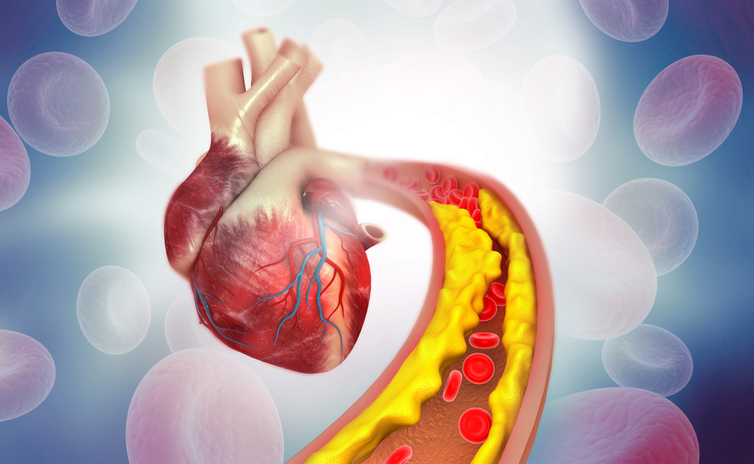Science
New Resource Identifies Genetic Risks for Heart Disease

An international research team from the University of Toronto and the University of Pittsburgh School of Medicine has developed a groundbreaking resource aimed at identifying individuals with a genetic predisposition to elevated low-density lipoprotein (LDL), commonly known as ‘bad’ cholesterol. This cholesterol type is a significant contributor to heart disease, which remains the leading cause of death in the United States, claiming nearly 700,000 lives annually.
The researchers classified nearly 17,000 missense coding variants of the LDL receptor (LDLR) gene and detailed the resulting changes in LDL receptor protein structure and function. This comprehensive mapping not only correlates genetic variations with their functional impacts but also offers insights that could enhance clinical diagnostics. The team believes that this resource will allow healthcare providers to better predict the risk of heart attacks and strokes, facilitating timely preventive measures.
According to Frederick Roth, PhD, who is the professor and chair of computational and systems biology at Pitt, “Even with normal LDL levels, a person might be at an elevated risk of a heart attack due to disease-causing variants in the LDL receptor.” Roth emphasizes the potential of this research, stating that by identifying harmful LDL receptor variants, clinicians can initiate preventive treatments earlier, ultimately mitigating risks.
The findings, published in the journal Science under the title “The functional landscape of coding variation in the familial hypercholesterolemia gene LDLR,” reveal how the team tested the effects of these variants on LDL receptor activity. The data produced sequence–function maps that not only reflect existing biochemical knowledge but also provide functional insights for interpreting clinical variants.
Heart disease risk is largely influenced by genetic factors, particularly the accumulation of plaque in the arteries due to elevated levels of LDL cholesterol. The authors note that genetic variants in the LDLR gene are among the most significant contributors to familial hypercholesterolemia (HeFH), a condition that can lead to premature cardiovascular issues. They indicate that variants in the LDLR gene can significantly raise circulating LDL cholesterol levels, thus increasing the risk of atherosclerosis.
“Variants in the familial hypercholesterolemia gene LDLR—the most important genetic driver of cardiovascular disease—can raise circulating low-density lipoprotein (LDL) cholesterol concentrations,” the authors explain. They further clarify that almost 80% of molecularly diagnosed HeFH cases are attributed to disruptions in LDL clearance caused by these genetic variants.
The ability to identify pathogenic LDLR variants can enhance diagnosis and therapeutic management, surpassing conventional lipid profiling methods. Despite advancements in gene sequencing technology that allow for rapid genetic analysis, the interpretation of the resulting data remains complex. The research team points out that many LDLR coding variants lack definitive clinical classifications, which restricts opportunities for early diagnosis and risk assessment.
For this study, Roth and his team classified close to 17,000 modifications of the LDLR gene, examining both cellular LDL uptake and LDL receptor cell-surface abundance. The resulting table offers a quantitative assessment of each protein variant based on its mechanism of action and impact on LDL clearance, equipping clinicians with actionable insights regarding their patients’ LDL levels.
The authors emphasize that these sequence–function maps not only enhance the understanding of LDLR function but also reveal unexpected biochemical insights, which could improve clinical variant interpretation. They suggest that functional scores correlate with hyperlipidemia phenotypes in human cohorts, indicating the resource’s potential to accelerate HeFH diagnosis and ultimately improve patient outcomes.
Dr. Dan Roden, a clinician-scientist at Vanderbilt University Medical Center and co-author of the study, highlighted the significance of these findings. He remarked, “New unclassified variants are seen all the time in the clinic, and we often don’t have the evidence we need to inform patient care.” The potential for these variant impact scores to increase diagnoses of familial high cholesterol by a factor of ten is particularly promising.
The research also uncovered a subset of LDL receptor variants whose ability to uptake LDL was inhibited by elevated levels of very low-density lipoprotein (VLDL), a precursor to LDL. This unexpected finding opens new avenues for investigation into the implications for human health, as explained by first author Daniel Tabet, PhD, from the University of Toronto.
This cholesterol-focused initiative is part of a larger project known as the Atlas of Variant Effects Alliance, co-founded by Roth, which aims to map the functional effects of genetic variants across inherited disorders. The alliance includes over 500 scientists from 50 countries, all working collaboratively to develop comprehensive maps that assess gene variants affecting a wide range of diseases.
The study represents a significant advancement in the understanding of genetic factors contributing to heart disease, promising to enhance preventive care and patient management on a global scale.
-

 Business2 weeks ago
Business2 weeks agoIconic Sand Dollar Social Club Listed for $3 Million in Folly Beach
-

 Politics2 weeks ago
Politics2 weeks agoAfghan Refugee Detained by ICE After Asylum Hearing in New York
-

 Health2 weeks ago
Health2 weeks agoPeptilogics Secures $78 Million to Combat Prosthetic Joint Infections
-

 Science2 weeks ago
Science2 weeks agoResearchers Achieve Fastest Genome Sequencing in Under Four Hours
-

 Lifestyle2 weeks ago
Lifestyle2 weeks agoJump for Good: San Clemente Pier Fundraiser Allows Legal Leaps
-

 Health2 weeks ago
Health2 weeks agoResearcher Uncovers Zika Virus Pathway to Placenta Using Nanotubes
-

 Science2 weeks ago
Science2 weeks agoInterstellar Object 3I/ATLAS Emits Unique Metal Alloy, Says Scientist
-

 World2 weeks ago
World2 weeks agoUS Passport Ranks Drop Out of Top 10 for First Time Ever
-

 Business2 weeks ago
Business2 weeks agoSan Jose High-Rise Faces Foreclosure Over $182.5 Million Loan
-

 Science2 weeks ago
Science2 weeks agoMars Observed: Detailed Imaging Reveals Dust Avalanche Dynamics
-

 Entertainment2 weeks ago
Entertainment2 weeks agoJennifer Lopez Addresses A-Rod Split in Candid Interview
-

 World2 weeks ago
World2 weeks agoRegional Pilots’ Salaries Surge to Six Figures in 2025







